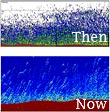U.S. researchers have developed broadband acoustic systems that they say will improve the ability to count and classify fish and zooplankton, an advance they liken to jumping from black and white television to high-definition TV. While oceanographers have long used acoustic measurements to determine what lies under the sea, existing technologies use sound waves that measure only one or a few frequencies, producing data that can be ambiguous and open to different interpretations, particularly for small fish and zooplankton. Two new systems developed by researchers at the Woods Hole Oceanographic Institution measure sound over a continuous range of frequencies, producing a broadband acoustic spectrum. Since the acoustic action for most fish occurs at low frequencies, many current echosounders miss their signal, said Tim Stanton, author of a study published in the International Council for Exploration of the Sea. The new broadband system allows researchers to distinguish between fish and other organisms, and identify the size and densities of fish. One of the systems was developed to find fish, while the other was developed to distinguish zooplankton from underwater turbulence.
Broadband Acoustic Technology Allows ‘High Def’ Underwater Imaging
More From E360
-
E360 Film Contest
The Amazon Rainforest Approaches a Point of No Return
-
Biodiversity
Shrinking Cod: How Humans Are Impacting the Evolution of Species
-
Cities
‘Sponge City’: How Copenhagen Is Adapting to a Wetter Future
-
INTERVIEW
On Controlling Fire, New Lessons from a Deep Indigenous Past
-
Solutions
Paying the People: Liberia’s Novel Plan to Save Its Forests
-
OPINION
Forest Service Plan Threatens the Heart of an Alaskan Wilderness
-
INTERVIEW
Pakistan’s Solar Revolution Is Bringing Power to the People
-
Food & Agriculture
In Uganda, Deadly Landslides Force an Agricultural Reckoning
-
Energy
Why U.S. Geothermal May Advance, Despite Political Headwinds
-
Food & Agriculture
In War Zones, a Race to Save Key Seeds Needed to Feed the World
-
Climate
Lightning Strikes the Arctic: What Will It Mean for the Far North?
-
RIVERS
A Win for Farmers and Tribes Brings New Hope to the Klamath
